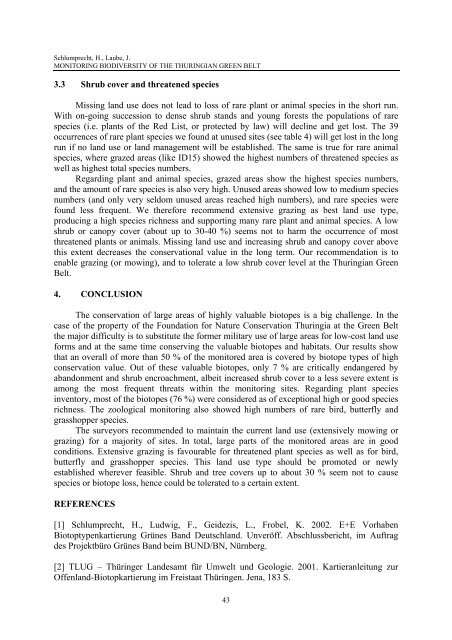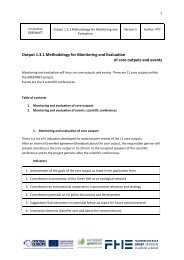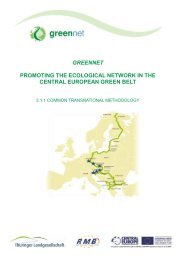The Green Belt as a European Ecological Network strengths and gaps
The Green Belt as a European Ecological Network strengths and gaps
The Green Belt as a European Ecological Network strengths and gaps
Create successful ePaper yourself
Turn your PDF publications into a flip-book with our unique Google optimized e-Paper software.
Schlumprecht, H., Laube, J.<br />
MONITORING BIODIVERSITY OF THE THURINGIAN GREEN BELT<br />
3.3 Shrub cover <strong>and</strong> threatened species<br />
Missing l<strong>and</strong> use does not lead to loss of rare plant or animal species in the short run.<br />
With on-going succession to dense shrub st<strong>and</strong>s <strong>and</strong> young forests the populations of rare<br />
species (i.e. plants of the Red List, or protected by law) will decline <strong>and</strong> get lost. <strong>The</strong> 39<br />
occurrences of rare plant species we found at unused sites (see table 4) will get lost in the long<br />
run if no l<strong>and</strong> use or l<strong>and</strong> management will be established. <strong>The</strong> same is true for rare animal<br />
species, where grazed are<strong>as</strong> (like ID15) showed the highest numbers of threatened species <strong>as</strong><br />
well <strong>as</strong> highest total species numbers.<br />
Regarding plant <strong>and</strong> animal species, grazed are<strong>as</strong> show the highest species numbers,<br />
<strong>and</strong> the amount of rare species is also very high. Unused are<strong>as</strong> showed low to medium species<br />
numbers (<strong>and</strong> only very seldom unused are<strong>as</strong> reached high numbers), <strong>and</strong> rare species were<br />
found less frequent. We therefore recommend extensive grazing <strong>as</strong> best l<strong>and</strong> use type,<br />
producing a high species richness <strong>and</strong> supporting many rare plant <strong>and</strong> animal species. A low<br />
shrub or canopy cover (about up to 30-40 %) seems not to harm the occurrence of most<br />
threatened plants or animals. Missing l<strong>and</strong> use <strong>and</strong> incre<strong>as</strong>ing shrub <strong>and</strong> canopy cover above<br />
this extent decre<strong>as</strong>es the conservational value in the long term. Our recommendation is to<br />
enable grazing (or mowing), <strong>and</strong> to tolerate a low shrub cover level at the Thuringian <strong>Green</strong><br />
<strong>Belt</strong>.<br />
4. CONCLUSION<br />
<strong>The</strong> conservation of large are<strong>as</strong> of highly valuable biotopes is a big challenge. In the<br />
c<strong>as</strong>e of the property of the Foundation for Nature Conservation Thuringia at the <strong>Green</strong> <strong>Belt</strong><br />
the major difficulty is to substitute the former military use of large are<strong>as</strong> for low-cost l<strong>and</strong> use<br />
forms <strong>and</strong> at the same time conserving the valuable biotopes <strong>and</strong> habitats. Our results show<br />
that an overall of more than 50 % of the monitored area is covered by biotope types of high<br />
conservation value. Out of these valuable biotopes, only 7 % are critically endangered by<br />
ab<strong>and</strong>onment <strong>and</strong> shrub encroachment, albeit incre<strong>as</strong>ed shrub cover to a less severe extent is<br />
among the most frequent threats within the monitoring sites. Regarding plant species<br />
inventory, most of the biotopes (76 %) were considered <strong>as</strong> of exceptional high or good species<br />
richness. <strong>The</strong> zoological monitoring also showed high numbers of rare bird, butterfly <strong>and</strong><br />
gr<strong>as</strong>shopper species.<br />
<strong>The</strong> surveyors recommended to maintain the current l<strong>and</strong> use (extensively mowing or<br />
grazing) for a majority of sites. In total, large parts of the monitored are<strong>as</strong> are in good<br />
conditions. Extensive grazing is favourable for threatened plant species <strong>as</strong> well <strong>as</strong> for bird,<br />
butterfly <strong>and</strong> gr<strong>as</strong>shopper species. This l<strong>and</strong> use type should be promoted or newly<br />
established wherever fe<strong>as</strong>ible. Shrub <strong>and</strong> tree covers up to about 30 % seem not to cause<br />
species or biotope loss, hence could be tolerated to a certain extent.<br />
REFERENCES<br />
[1] Schlumprecht, H., Ludwig, F., Geidezis, L., Frobel, K. 2002. E+E Vorhaben<br />
Biotoptypenkartierung Grünes B<strong>and</strong> Deutschl<strong>and</strong>. Unveröff. Abschlussbericht, im Auftrag<br />
des Projektbüro Grünes B<strong>and</strong> beim BUND/BN, Nürnberg.<br />
[2] TLUG – Thüringer L<strong>and</strong>esamt für Umwelt und Geologie. 2001. Kartieranleitung zur<br />
Offenl<strong>and</strong>-Biotopkartierung im Freistaat Thüringen. Jena, 183 S.<br />
43




